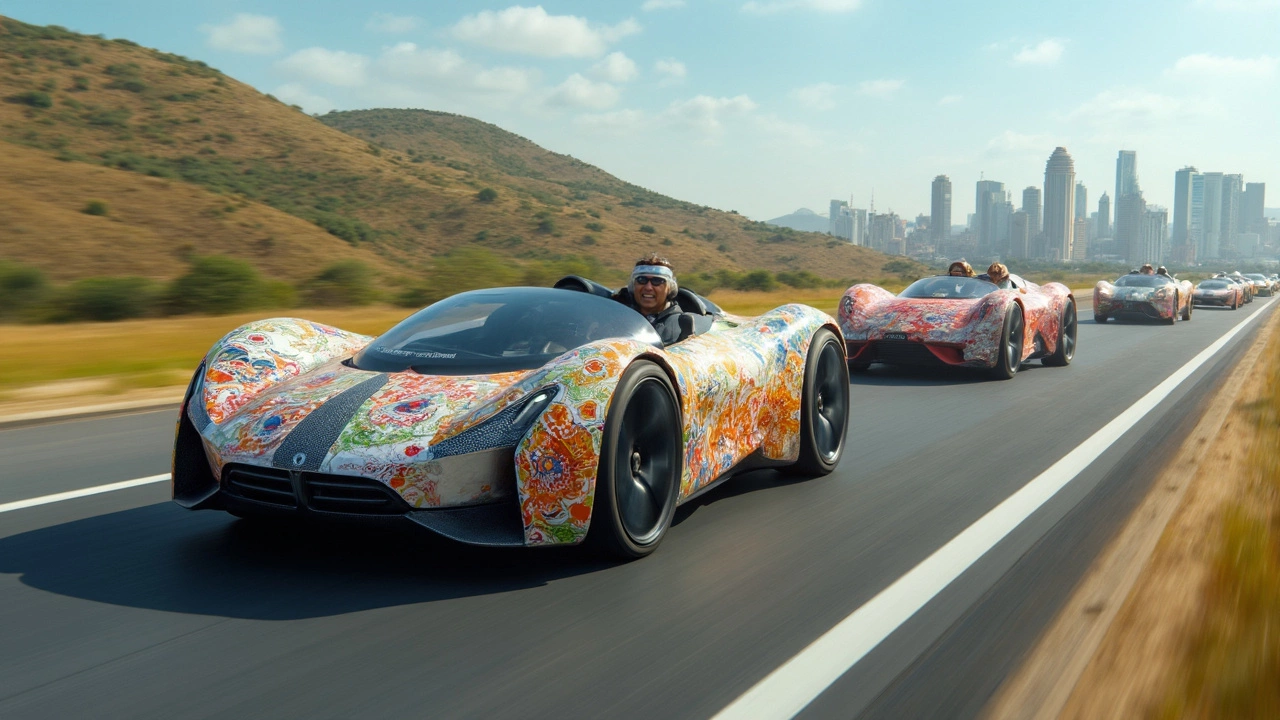Have you ever wondered which car from India's bustling factories rolls across foreign borders the most? No, it's not a luxury sedan or a flashy supercar. The title goes to an unexpected contender in the SUV market, the Hyundai Creta. This compact SUV has carved out a niche for itself, becoming the most exported vehicle from India.
Why the Creta? A few reasons make this car a favorite. First, it's the blend of style and practicality. Indian manufacturers hit the sweet spot with just the right features and design that appeal globally. Plus, affordability gives it an extra edge in competitive markets.
Another reason is the global shift towards SUVs. People across various countries are leaning towards bigger vehicles that offer space without compromising on comfort. The Creta fits snugly into this demand.
- Introduction to Indian Car Exports
- The Leader: Most Exported Car
- Factors Contributing to Success
- Impact on India's Economy
- Future of Car Exports from India
Introduction to Indian Car Exports
India's automobile sector isn't just huge in terms of domestic supply—it's also a key player in the global game. This might surprise some folks, but the subcontinent isn't only known for its spicy food and colorful festivals. Car exports are thriving, and they aren't just a side gig. It's a serious business that impacts trade balances and economic growth.
A few decades ago, who would have thought India would become a significant hub for car exports? The scene was once filled with rugged ambassadors and quirky Premier Padminis. Fast forward to the present, and you'll find India churning out tech-savvy, economically viable cars heading to all corners of the globe.
Presently, India ranks among the top exporters, particularly in the compact and mid-sized segments. Cars from India reach over 125 countries with Latin America, Africa, and the Middle East featuring prominently on the buyers' list. This move has been propelled by a perfect storm of rising global demand for affordable vehicles and India's push to modernize its manufacturing capabilities.
Take Hyundai and Maruti Suzuki. They're like the rockstars of the industry here. Hyundai alone sold over 1.3 million vehicles from its Indian plants as exports between 2020 and 2023. Meanwhile, Maruti Suzuki has grown a fan base outside of India with its reliable, budget-friendly models.
So why is India so enticing for car manufacturing? Well, you've got cost-effective production methods, skilled labor, and let's not forget the Make in India initiative—a government-backed push to lure more businesses to the subcontinent. All these factors make it a sweet spot for companies aiming to produce cars that go easy on the wallet while ticking the right boxes for quality and performance.
The Leader: Most Exported Car
In India's massive auto landscape, the Hyundai Creta reigns supreme when it comes to exports. This compact SUV is not only popular on Indian roads but has also made a significant impact in markets far and wide. What's the secret sauce behind its export success?
Firstly, let's talk about the irresistible design. The Creta isn’t just about good looks; it’s practical, too. This SUV got a facelift to keep up with modern tastes and offers a versatility that customers crave. It's the sort of car that checks all boxes when it comes to both form and functionality. Because of this, Creta’s become the go-to choice in several emerging markets looking for reliability without breaking the bank.
Mileage, Meet Performance
Another critical factor is its balanced performance. The Creta is renowned for blending decent mileage with impressive power, making it suitable for both daily use and long drives. It's got choices, whether you want to drive petrol or diesel, manual or automatic, giving it outstanding flexibility.
Production Prowess
Hyundai’s manufacturing efficiency in India is another reason the Creta tops export charts. The Chennai plant is one of Hyundai’s most advanced facilities, ensuring high-quality standards that meet international expectations. This advantage ensures that Indian-made Creta units hold their own globally.
Here’s a look at the numbers that speak volumes about its export journey:
| Year | Units Exported |
|---|---|
| 2022 | 112,000 |
| 2023 | 119,500 |
These figures aren't just numbers; they tell the story of a car that resonates globally. Despite various challenges in the automotive industry, the Creta has consistently maintained an upward trajectory in its export journey.
Global Presence
Creta finds big fans not just in nearby countries but also far-off destinations in South America and the Middle East. Wherever roads need reliable vehicles, you'll likely find the Creta paving its way.
All these reasons combined make the Hyundai Creta a runaway success as India’s top exported car. Car exports have indeed helped put India on the global automobile map, and the Creta leads the charge.

Factors Contributing to Success
The journey of the Hyundai Creta to becoming India's most exported car isn't just about luck. Several crucial factors played pivotal roles in catapulting this SUV into international stardom.
1. Optimal Pricing
Price matters. The Hyundai Creta strikes a balance between affordability and features, making it appealing in international markets where budget-conscious customers don't want to sacrifice quality. This car is perfectly placed to compete in regions like South America, Southeast Asia, and even parts of Europe.
2. Adaptive Design
The Creta has a globally attractive design. Hyundai's designers kept versatility in mind, making sure the vehicle aligns with different international tastes. Its contemporary and sleek profile is spot-on for a variety of markets.
3. Reliable Performance
People want reliability. Creta’s solid engineering ensures it performs well across diverse climates, from the rainy streets of London to the sun-baked highways of Brazil. Its robust engine options and efficient fuel consumption are big selling points.
4. Strategic Manufacturing
Positioning factories in India isn't just about cost savings; it’s strategically leveraging the country’s manufacturing ecosystem. India’s robust supply chain, skilled labor force, and favorable government policies create an ideal environment for producing and exporting automobiles at scale.
5. Rising SUV Demand
There’s no denying it—SUVs are hot. Global demand for SUVs has skyrocketed in the past decade. Hyundai capitalized on this trend by ensuring the Creta met and exceeded expectations consumers have for sport utility vehicles.
6. Strong Brand Reputation
The Hyundai brand itself carries weight internationally. Known for delivering reliable and value-for-money vehicles, Hyundai’s reputation aids the Creta’s acceptance everywhere it goes.
By combining these factors, the Hyundai Creta demonstrates how clever market positioning, coupled with understanding consumer desires, can make a model a top exporter from a country like India, changing the global automobile landscape in unexpected ways.
Impact on India's Economy
When it comes to cars like the Hyundai Creta leaving Indian shores, it's more than just vehicles getting exported. There's a whole trickle-down effect on the Indian economy you might not have thought about.
First off, car exports significantly boost India's foreign exchange reserves. It's like an influx of international cash flowing into the country, which helps maintain a favorable trade balance.
Creating Jobs
Every car built for export means jobs for people. From skilled engineers designing the cars to assembly line workers crafting them, it's an employment machine. According to a report, the automobile industry is responsible for generating direct and indirect employment for over 35 million people in India.
Growth of Auxiliary Industries
Plus, with more cars going abroad, auxiliary industries like parts suppliers and logistics benefit too. This means they get involved in the export chain and contribute to the economy's growth. Larger orders for parts mean scale economies, bringing down costs and boosting profits.
Technology Advancements
Exporting cars means you need to meet global standards, which pushes Indian manufacturers to innovate. This tech advancement is crucial not just for staying competitive globally but also for trickling those advances into other sectors within the country.
Interestingly, in 2023, India's automobile exports were worth approximately USD 12 billion. Here's how the export data for that year spread across different segments:
| Segment | Export Value (USD Billion) |
|---|---|
| Passenger Vehicles | 5.2 |
| Commercial Vehicles | 2.1 |
| Three Wheelers | 2.5 |
| Two Wheelers | 2.2 |
So, every time a car export happens, it's not just a shipment. It's a catalyst for broader economic gains, pushing the industry—and the nation—forward.

Future of Car Exports from India
Looking ahead, the future of car exports from India seems brighter than ever. With an increasing number of international brands setting up manufacturing in the country, India's role in the global automobile market is set to expand.
One of the key drivers for this growth is the government’s push towards ‘Make in India’, which encourages domestic manufacturing. By offering incentives to car manufacturers, the initiative aims to boost production and, consequently, exports. This is coupled with the development of infrastructure and reduction in bureaucratic hurdles, making trade more seamless.
Electric Vehicles: The Next Big Wave
As the world shifts towards cleaner energy, India is also gearing up for increased export of electric vehicles (EVs). Manufacturers are already investing heavily in technology to develop affordable EVs tailored for export markets. This could position India as a hub for electric mobility solutions, making significant strides in automobile manufacturing.
Furthermore, India is not just looking at traditional markets. Regions like Africa and South America are becoming key targets for Indian car exporters, tapping into these emerging markets with the promise of reliable yet affordable vehicles.
Challenges and the Road Ahead
However, challenges like tariff barriers and competition from other manufacturing giants like China and South Korea remain. Indian producers must continually innovate and maintain quality to stay competitive.
There's also the matter of sustainability. As consumers worldwide become more eco-conscious, Indian manufacturers need to ensure that their processes are environmentally friendly to maintain their global appeal.
Overall, with strategic planning and continuous evolution, the future of Indian car exports looks promising. The country's potential to become a global player in the automobile sector hinges on how well it adapts to changing global demands and market conditions.

